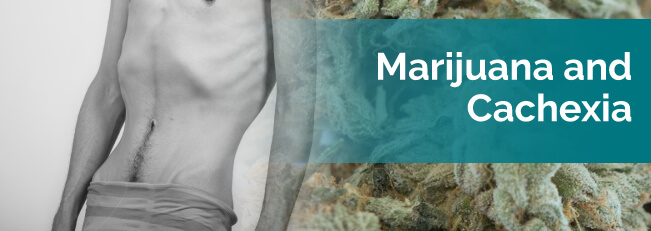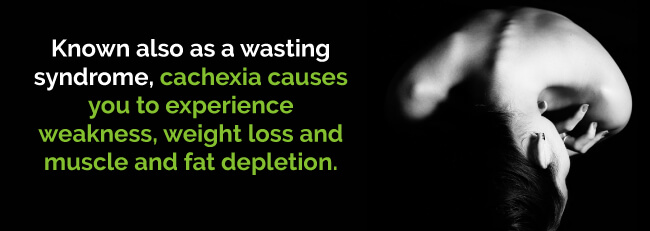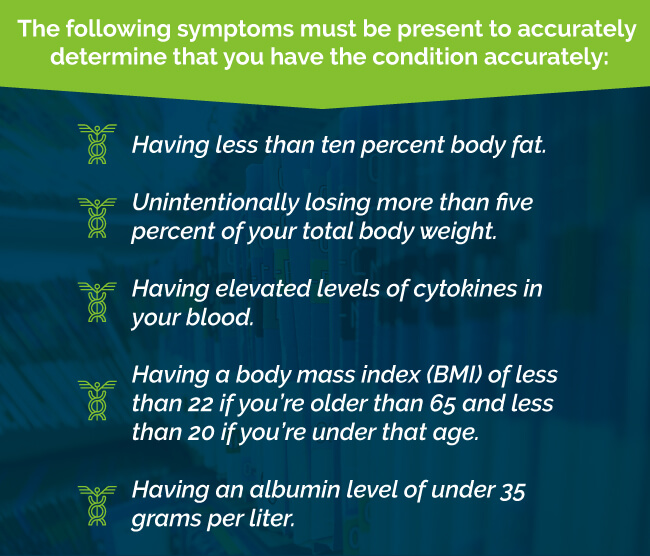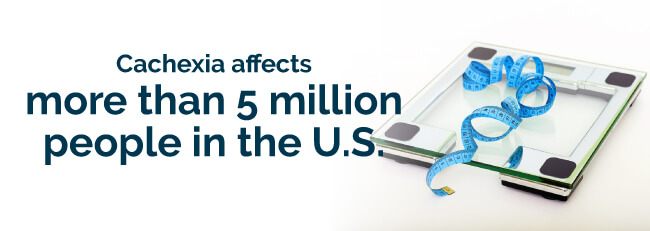
You’ll be understandably concerned if your physician diagnoses you with cachexia, as this wasting disorder is often associated with a severe illness. You could find that you can’t eat and that you lack the energy you once had, and you could even notice your physical condition begin to deteriorate. Because of these symptoms, you’ll likely lose a lot of weight, too.
After you’ve been diagnosed, you’ll probably have many questions about cachexia and how to manage it. Here, you can learn more about medical marijuana for cachexia and how it may help you or a loved one with the condition.
Known also as a wasting syndrome, cachexia causes you to experience weakness, weight loss and muscle and fat depletion. It affects patients with AIDS and advanced cancer, in addition to some other major chronic progressive diseases.
The condition occurs in people who aren’t trying to lose weight. Cachexia also affects the elderly without any underlying cause. Anorexia and cachexia often occur together.

It’s imperative to differentiate between cachexia and other conditions that cause weight loss to receive a timely diagnosis and to manage the condition effectively. Cachexia sets in during the latter stages of chronic illness. It is most commonly seen in patients with the following conditions:
If you have cachexia, you have incorrect levels of some substances in your body. It’s this issue that causes your muscles to waste and for you to lose weight. The substances that prevent your muscles from growing and contribute to them wasting include higher levels of the hormone myostatin, elevated levels of glucocorticoids (hormones made by your kidneys) and raised levels of insulin-like growth factor l (IFG-l). You may also have low testosterone levels.
Higher than average levels of cytokines (inflammatory substances that contribute to weight loss) prompt your weight loss. Having elevated amounts of cytokines in your blood is sometimes associated with one of the aforementioned long-term health conditions.
The word cachexia derives from the Greek words for bad, “kakos,” and condition, “hexis.” It’s a familiar condition for patients in palliative-care settings and those with certain end-stage diseases.
There have been increasing numbers of clinical trials and studies into cachexia over the last decade, and the understanding of the condition has significantly improved throughout this time. However, lack of agreement on treatment pathways, classification and diagnostic criteria has held back progress in clinical trials.
Cachexia used to be overlooked by doctors – nowadays, physicians and researchers view it as a distinct condition. Unfortunately, some major clinical trials in recent years have not had positive results, ultimately raising concerns about loss of funding from the pharmaceutical industry. It’s clear that far more research should be conducted into the condition. Medical cannabis is now being used to treat some of the symptoms of cachexia.
You may not seem malnourished when you have cachexia. You won’t immediately look emaciated if you were overweight when you developed your chronic illness. On the other hand, cachexia may be quite apparent if you’re a slight individual.
Doctors use a variety of criteria to diagnose cachexia as the condition is often difficult to recognize. The following symptoms must be present to accurately determine that you have the condition:

You’re usually already suffering from an underlying chronic illness when you have cachexia. Both conditions come with a whole host of negative and uncomfortable symptoms. You may find your chronic condition symptoms worsen due to cachexia and vice versa. You’ll likely notice a diminished quality of life, and you may not respond well to treatments. You’ll also be susceptible to the effects of a reduced immunity level. It’s likely that you’ll feel constantly fatigued and might become depressed.
It’ll be difficult to carry out activities that you once found easy – even having a phone conversation might take all your strength. Your body has nowhere to store its nutrients as they’re kept in your muscle and fat, which are wasting away. Your body functioning is severely impacted, and you may become very sick as a result. Thankfully, there are treatments options, including medical marijuana, to help with your wasting syndrome symptoms.
Cachexia affects more than five million people in the U.S.

The National Institutes of Health reports its prevalence concerning advanced cancer and end-stage heart failure as follows:
|
Condition |
Prevalence |
|
End-Stage Heart Failure |
5-15 percent |
|
Advanced Cancer |
50-80 percent |
Cachexia is also seen in as many as 60 percent of people with chronic kidney disease. It also frequently occurs in patients with rheumatoid arthritis, neurological diseases and chronic obstructive pulmonary disease (COPD).
To date, there is no broadly accepted medication to treat cachexia, but nutritional supplements and steroids help to provide needed nutrients. To help cancer patients retain some muscle mass, a 2009 clinical trial discovered that an eicosapentaenoic acid supplement was helpful.
Researchers are studying how human growth hormone (HGH) treatments might help patients with wasting syndrome, but it’s an expensive treatment which could cost more than $40,000 annually. Somatropin (Serostim) is one human growth hormone that helps you build lean body mass and to gain weight. A downside is that is causes joint and muscle pain and high blood sugar.
Your doctor may prescribe you megestrol acetate (Megace) to stimulate your appetite. One drawback of this is that it can slow down the release of sex gland hormones while also building body fat. Anabolic steroids and testosterone could help you build up muscle. However, they can lower your good cholesterol and potentially cause irregular periods or male infertility. Taking thalidomide can reduce your cytokine levels but also causes burning or tingling in your arms or legs and potential muscle weakness.
Dronabinol (Marinol) is a man-made form of an active ingredient in cannabis. The drug can stabilize your weight and improve your mood. However, insurance companies often won’t pay for it. Perhaps this is why people with cachexia are heading toward medical marijuana to help manage their symptoms.
In order to manage cachexia, patients need to increase their food intake by managing vomiting and nausea, and according to anecdotal and scientific and evidence, using medical cannabis is an effective and safe method to do this.
The National Cancer Institute (NCI) is evaluating the effects of THC (Tetrahydrocannabinol (psychoactive compound in marijuana) for cancer-related anorexia and treatment-related cachexia. THC-dominant strains of cannabis seem to be the best for treating cachexia. The most effective route of administration appears to be sublingual and oral.
To date, many states have included cachexia on their list of qualifying conditions. Alaska, Arizona, Arkansas, California, Colorado, Connecticut, Delaware, Hawaii, Illinois, Maine, Maryland, Michigan, Minnesota, Montana, Nevada, New Hampshire, New Mexico, New York, North Dakota, Oregon, Rhode Island, and Vermont have approved cachexia as a qualifying condition for the use of medical marijuana.
Also, cannabis, marijuana side effects are classified as “low risk,” and are typically mild, with euphoric-mood type changes being among the most frequent side effects.
The Food and Drug Administration (FDA) approved Dronabinol, a synthetic THC derivative in 1985 for the wasting associated with HIV/AIDS. Studies have proved its efficacy. The drug is also prescribed to chemotherapy patients to minimize nausea and vomiting. The problem is that it’s expensive.

A 2007 Columbia University study discovered that giving AIDS patients with cachexia oral cannabis significantly stimulated their appetites, promoted weight gain and increased their calorie intake. Another 2011 study found that cancer patients treated with THC increased their appetite by 64 percent.
You’ve no doubt heard about the appetite-stimulating properties of weed. Marijuana is notorious for giving people “the munchies.” Not only this but pot treats nausea, vomiting, depression and general malaise you feel when you have cachexia. Let’s look at some of the best strains to use for alleviating your cachexia symptoms.
Pot remains illegal on a federal level in the U.S. However, many states have legalized its medical and recreational use. You must have a condition that’s on your own state’s list of qualifying medical pot conditions to qualify for medical cannabis for cachexia, and you’ll need to have a medical marijuana doctor’s recommendation too. You can then obtain a medical marijuana card.
Once you have approval, you may visit dispensaries and buy medical cannabis products for your needs. If recreational use is legal in your state, you won’t need a medical marijuana card. However, you might not have access to the same medical pot products that are available for people with qualifying health conditions.
There are many different strains of medical marijuana for cachexia available to buy from dispensaries. Each strain has its own unique effects. It’s recommended to have a chat with a knowledgeable budtender or your medical marijuana doctor to find out what’s best suited to you. In the meantime, take a look at this short list for more information.
Lack of appetite is arguably the main symptom you want to treat when you have cachexia. You might find that your nausea and vomiting improve when you’re eating well. Take a look at the following three strains that could help you.
Taking pot can help you eat, keep your food down and combat weight loss and muscle wasting. The following cannabis strains can help treat nausea and vomiting:
Cannabis is useful for improving your mood. In fact, people have been using pot to self-medicate for many years. Understandably, your mood is less than upbeat when you’re ill. If your emotional well being turns into depression, you feel alone, down and might not have the get-up-and-go even to get up in the morning. Thankfully, the following strains may assist you in dealing with the blues:
Chronic illness saps your energy. You probably feel sick and tired of always being sick and tired. Having little energy gets you down. You might have lost interest in activities you once enjoyed, and your social life could be suffering. These three sativa strains are helpful if a lack of energy is an issue for you:
Now have an idea of some of the most effective strains of medical pot for cachexia, let’s look at how best to take it. Your health is already suffering. Therefore, you probably won’t want to smoke cannabis. So, what are the alternatives?
The above methods eliminate the need to smoke pot and enable you to try different methods of ingestion until you find the one that best suits you.
Cachexia is a complex condition that requires further research. Although the disorder is unlikely to be adequately treated with cannabis alone, the substance goes a long way to help alleviate your symptoms. Marijuana and its extracts have cemented their place as medications that have significant benefits if you have cachexia. Cannabis for cachexia can help you increase your appetite – and therefore your body weight – leading to an improved quality of life.
If you or someone close to you is searching for a way to gently and naturally relieve your symptoms, search for a medical marijuana doctor or dispensary today to find out more about marijuana and cachexia.
Find A Doctor Find A Dispensary